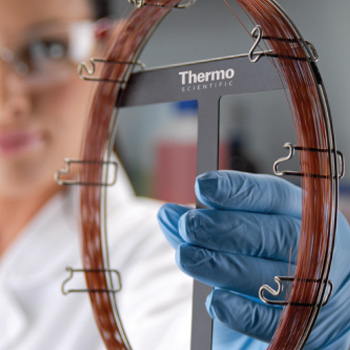GC Column Selection—Optimize Your Analysis

When selecting a gas chromatography (GC) column for your analysis, it can often be difficult to choose the most appropriate column because of the wide range of options. However, the choice can be simplified by considering a number of questions about the planned separation. This section provides useful information to help you determine the most suitable column for your analysis.
Method Development Considerations
 When first developing a method, you should consider these column characteristics to determine the best column for the separation.
When first developing a method, you should consider these column characteristics to determine the best column for the separation.
A. Column Phase
B. Internal Diameter
C. Film Thickness
D. Column Length
A. Column Phase
In GC, the separation of two analytes occurs due to differences in their interactions with the stationary phase; therefore, a phase must be chosen that matches the properties of the sample. For example, if the components have different boiling points (greater than 2 °C), a non-polar column, such as the TG-1MS, is recommended. If the products differ primarily in their polarities, then a polar column, such as the TG-WAXMS, will be ideal.
If you know the particular class of your sample, please refer to the column selection by application for a recommended phase. Always select the least polar column that will perform the separation.
B. Internal Diameter
The selection of the internal diameter (ID) is often determined by the instrument or detection method. Most modern GC equipment will accommodate most column sizes. With a larger internal diameter, column sample capacity increases, but resolution and sensitivity decrease. Conversely, a smaller ID column can improve resolution and sensitivity, but with the drawback of reduced sample capacity and a greater need for sample preparation. It is a good idea to find a similar application that gives separation of the desired components and use this as a guide.
C. Film Thickness
Increasing the film thickness increases the sample capacity of the column and slows the elution of the peaks, which can help during analysis of volatile compounds. A thicker film also reduces the potential of overloading the column, thus improving the resolution. However, a thicker film can be more sensitive to degradation. The same component will elute at a higher temperature on a thick film compared to a thin film.
Compounds with high boiling points or those with high molecular weights should be analyzed using a thin film to improve resolution and avoid unnecessarily long analysis times.
Another factor to consider is the phase ratio (b), which is calculated using both the ID and film thickness (the ratio of a column’s volume of stationary phase to mobile phase) in the following equation:
ß = ID (µm): 4× film thickness (µm)
The phase ratio can be used in two ways:
1. To categorize the best dimensions for an application:
a. For volatile samples, ß < 100
b. For general samples, ß ~ 250
c. For high molecular weight
samples, ß > 400
2. To transfer an analysis from a column of one ID to another without changing the method substantially, choose a column with a similar b value, as this will have similar retention properties.
D. Column Length
A longer column length will provide greater efficiency and resolution, but this is not a linear relationship. Resolution is proportional to the square root of column length, so doubling the column length will increase resolution by approximately 40%. However, increasing the column length will also increase the retention time. Double column length equals twice the analysis time. Generally, it is recommended to use the shortest column that will perform the desired separation.
Additional Considerations
Several generalizations regarding GC columns exist that you might rely upon when in doubt. First, 95% of all GC columns used are either TG-1MS-, TG-5MS- or TG-WAXMS-type columns. A good starting column is a 30 m × 0.25 mm ID, 5% phenyl column with a 0.25-µm film thickness, such as the TG-5MS. This is a non-polar column, which separates predominately on boiling point, but has some polar characteristics.
www.thermoscientific.com/chromatography
Looking for a reprint of this article?
From high-res PDFs to custom plaques, order your copy today!






